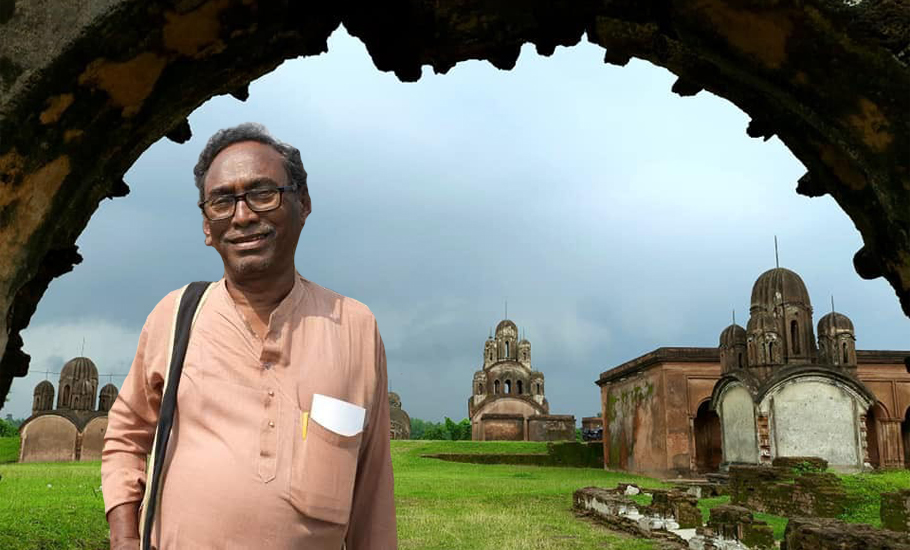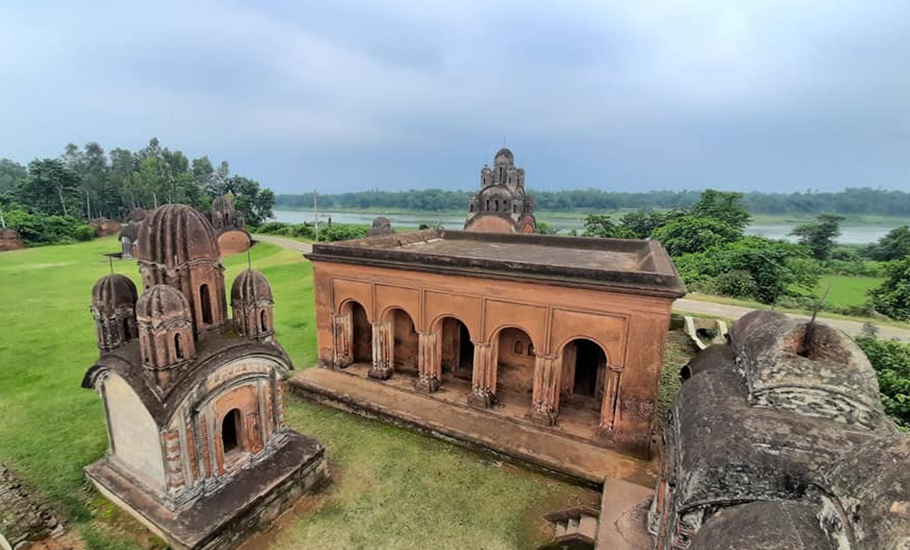
- Home
- News
- Analysis
- States
- Perspective
- Videos
- Education
- Entertainment
- Elections
- World Cup 2023
- Features
- Health
- Business
- Series
- Economy Series
- Earth Day
- Kashmir’s Frozen Turbulence
- India@75
- The legend of Ramjanmabhoomi
- Liberalisation@30
- How to tame a dragon
- Celebrating biodiversity
- Farm Matters
- 50 days of solitude
- Bringing Migrants Home
- Budget 2020
- Jharkhand Votes
- The Federal Investigates
- The Federal Impact
- Vanishing Sand
- Gandhi @ 150
- Andhra Today
- Field report
- Operation Gulmarg
- Pandemic @1 Mn in India
- The Federal Year-End
- The Zero Year
- Premium
- Science
- Brand studio
- Home
- NewsNews
- Analysis
- StatesStates
- PerspectivePerspective
- VideosVideos
- Entertainment
- ElectionsElections
- Sports
- Loading...
Sports - Features
- BusinessBusiness
- Premium
- Loading...
Premium

What it took a Muslim man to save temples that Hindus were plundering

It was a cold December day in 1982. The then Midnapore district magistrate Amit Kiran Deb was taken aback when a lanky young man approached him seeking protection. Mohammed Yeasin Pathan told the district magistrate that he was being targeted by some influential Hindu residents of a nearby village for preventing them from destroying ancient temples, whose bricks they were plundering...
It was a cold December day in 1982. The then Midnapore district magistrate Amit Kiran Deb was taken aback when a lanky young man approached him seeking protection. Mohammed Yeasin Pathan told the district magistrate that he was being targeted by some influential Hindu residents of a nearby village for preventing them from destroying ancient temples, whose bricks they were plundering for sale.
Prior to that incident, not many outside the village knew about the silent crusade that Pathan had initiated to preserve and protect Hindu shrines dotting Pathra, a rich slice of Bengal’s history long forgotten.
Pathra, an unassuming village on the banks of Kangsabati river, some 140 kilometres west of Kolkata, is a treasure trove of history dating back to the Gupta dynasty. Located within the vicinity of the legendary Tamralipta, a bustling port city of ancient India, the place was an important centre of Hindu, Jain and Buddhist cultures from 8th to 12th century.
A Vishnu Lokeshwar statue unearthed in the village in October 1961 had revealed the synergic influence of Hinduism and Buddhism in the area. Later in the 18th century, Pathra gained prominence as a temple town when Nawab Alivardi Khan appointed Bidyananda Ghoshal as the revenue collector of the area. A devoted Brahmin, Ghosal spent most of the collection in building a series of terracotta temples dedicated to pantheons of Hindu deities, to the extent of drawing the wrath of the nawab who sentenced him to death for such “misuse” of revenue.
Descendants of Ghosal continued to build temples in the area till the end of the 18th century and beginning of the 19th century. In the later period, the temple construction was funded by the family with earnings from indigo cultivation and silk trade.
If Ghosal showed the will to build the temples, Pathan, now 70 years old, is showing the zeal to protect these.
Some of these shrines are still standing tall only because Pathan ran from pillar to post to ensure these structures are not reduced to rubbles due to government’s apathy and the ignorance of villagers who took the ancient monuments as a source of construction material.

“There were around 52 temples in Pathra till the 1990s. Several of these had either been gobbled up by the river or reduced to dust due to neglect and despoil,” Pathan told The Federal.
But as one visits the village of red soil, several temples could still be seen jutting out from trees, scattered amid swathes of paddy fields, water bodies and human habitations.
A Navratna temple will immediately draw the attention not only because it is perhaps the largest of all the surviving architecture in the vicinity, but also because the west-facing temple built around 250 years ago is a wonderful exhibit of terracotta artworks that adorned its walls.
Not far from there flows the Kangsabati river, quietly witnessing the changing fortune of the village.
On the other side of the road, there stand three temples built in Bengal’s famous aat-chala style of architecture (a typical temple architecture style with triple entrances giving onto a porch. The roofs are mostly rounded or straight-edged pyramidal.) A small Shivalaya can also be seen nearby.
Behind them lies an ancient temple-like structure made of stone, called Durga Dalan or Durga Mandap. It’s this structure that Pathan went to protect when he was assaulted in 1982. A few Pancharatna terracotta temples deep inside the village survived the vagaries of time and plunder due to the tireless efforts of one man’s ‘save-temple mission’.
Pathan embarked on the mission in 1971 as a teenager after getting in touch with Tarapada Santra, who was researching the history and archaeology of the region.
“Visiting historic places with him, I got to know the importance of these relics of the bygone era and developed a passion for their preservation,” he said.
Ironically, initially both Muslims and Hindus opposed him. Muslims saw his mission as an unnecessary intrusion into the matters of another religion. Hindus, on the other hand, did not like being lectured by a Muslim about the need to protect their own religious structures.
After much persuasion, in 1990, Pathan could convince a large number of Hindu and Muslim villagers to come together to form the Pathra Archaeological Preservation Committee (PAPC) to prevent the destruction of structures of historical and religious importance.
The turning point came four years later when he got a President’s award for promoting communal harmony in 1994.
“That was the first time I went to New Delhi. During my stay there, I happened to meet Pranab Mukherjee, who was the deputy chairperson of the Planning Commission at the time,” Pathan recalled.
When Pathan told Mukherjee about the ancient ruins of Pathra, the latter directed him to collaborate with IIT-Kharagpur to prepare a project to renovate the relics. Accordingly, a project was prepared and the commission initially sanctioned an amount of Rs 20 lakh for the restoration work.
But the then Left Front government in West Bengal wanted to use the money to tame the river on the pretext that embankment would protect the temples from river erosion. However, following objections from the PAPC, the state government’s move was thwarted and the plan panel handed over the money to the Archaeological Survey of India (ASI) and asked it to restore the five temples.
Again after relentless paperwork and persuasion, the government of India issued a Gazette notification in 2003 for acquisition of 26 temples, including the five already restored, and 25 bighas of adjoining land by the ASI for the protection of the ancient site. Of these 26 structures, 19 have already been restored, according to the ASI.
The restoration work, however, has been stalled now because the villagers whose land was acquired for the project did not get the promised compensation from the ASI.
“Even after the lapse of almost two decades, the ASI is yet to pay us for the takeover,” Mritunjoy Banerjee, a landowner, told The Federal.
Angry landowners locked the local ASI office a few months ago stating that they would not allow it to function in the village if the compensation was not paid. In the tussle between the ASI and the landowners, Pathan finds himself in an awkward position as many villagers now blame him for their plight.
“The farmers gave their land to the ASI only after I convinced them. Now, they call me a betrayer, a Mir Jafar,” the 70-year-old temple-restorer lamented.

Despite his ill health, Pathan said he had been constantly writing to the authorities concerned to pay the due compensation amount to the villagers and resume the restoration works.
Even the West Bengal government and Congress leader Adhir Ranjan Chowdhury raised the issue with the BJP-led government at the Centre. But so far, they have only got assurance. In September, Union Minister of State for Finance Pankaj Chaudhary, during his visit to Midnapore, met Pathan. He too assured him that the compensation issue would be resolved soon.
“It is ironic that the BJP, which spends so much time and energy looking for imaginary temple structures buried under some historical monuments, is so oblivious to the ancient shrines lying over the ground,” a Pathra villager, who didn’t want to be named, said matter-of-factly.

